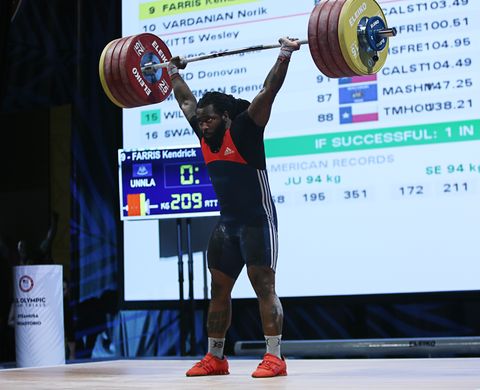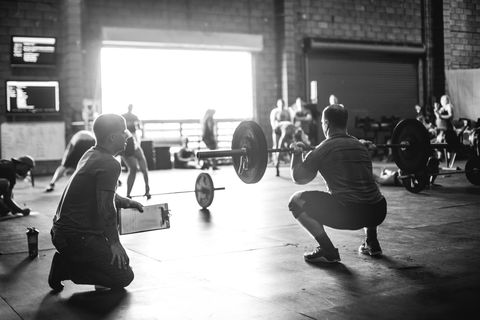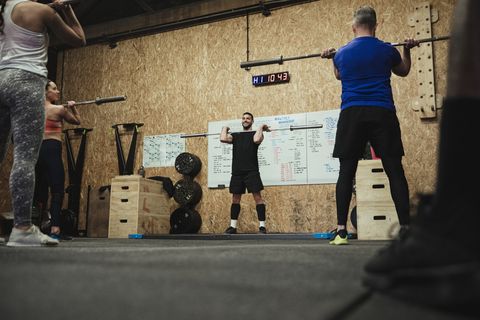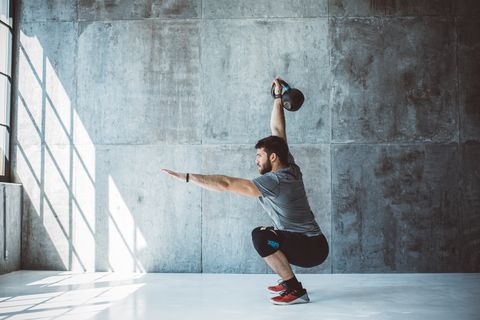
Editor’s note: This article is an op-ed. The views expressed herein are the author’s and don’t necessarily reflect the views of Men’s Health or the subjects interviewed.
Whether you’re new to the gym or you’ve been lifting for years, there’s a good chance you haven’t mastered Olympic weightlifting with barbells. But if you walk into a CrossFit box fresh off the street, there’s also a chance that you might be tasked with taking on the complicated maneuvers of the sport without much more prep than a brief set of instructions.
Still a niche sport despite its status as one of the oldest disciplines at the Olympiad, Olympic weightlifting involves using two lifts to move as much weight as you can overhead: first with three attempts at a snatch (ground to overhead in one fluid motion), then at the clean and jerk (ground to your collarbone, then thrust overhead).
When described as such, the maneuvers seem straightforward enough—but calling Olympic lifts difficult is an understatement.
“To establish the requisite foundation for the movements, we have to make sure athletes have the perfect amount of balance, tension, stability, and mobility,” says Cara Heads Slaughter, a former Olympian and current USA Weightlifting coach. “It could be six months before they have what looks like a coordinated, full, classic movement.”
Olympic lifting is the most complex things you can do with a barbell; the complexity makes the maneuvers both extremely beneficial for athletes, but also extremely difficult to do properly. That paradox brings us to the central conflict at hand: casual CrossFitters shouldn’t be tasked with doing them—at least not in the ways they currently are—as part of their workouts.
Where CrossFit Uses Olympic Lifting
The idea of CrossFit is to get as good as you can in as many areas of fitness as possible: cardiovascular and respiratory endurance, stamina, strength, flexibility, power, speed, coordination, agility, balance, and accuracy. Specialization is anathema to the practice, since you need to be versatile to last through a week of WODs.
To be clear, that concept isn’t harmful in and of itself, and countless people have improved their lives with CrossFit. Instead of getting elite in one area of fitness (say, running or powerlifting), you get good-but-not-amazing using barbells, kettlebells, running, basic gymnastics, and plyometrics.

To achieve that, CrossFit throws everything but the kitchen sink at their “athletes,” the word they use for “customers”—let’s remember, most average Joes in a CrossFit box on a given day aren’t five-time Games champ Mat Fraser, a former Team USA Olympic weightlifting hopeful.
A given week at CrossFit can involve back squat max outs, box jumps, jumping rope, wall balls, gymnastic ring work, kettlebells, and, of course, Olympic weightlifting. This is training meant for athletes—but it’s important to remember that not everyone who enters the box has peak performance in the forefront of their mind. People use CrossFit to get in shape, find community, and more, but they can find themselves taking on workouts designed for the elite athletes who compete in the sport’s Games championship event.
Olympic Lifts Are Very Difficult
And why wouldn’t a sport that’s aiming to train as many areas of fitness as possible not include Olympic lifts, which stands up as one of our most potent displays of strength and power?
Because these lifts are really, really hard, and many CrossFit gyms will require them of any untrained civilian who walks through their doors.
CrossFit’s company philosophy emphasizes not micromanaging its affiliates, a holdover from disgraced former CEO and founder Greg Glassman’s regime. After getting an official training certification or two, anyone is allowed to open a gym and train their customers however they like. In some cases, box owners might ask more of their instructors and gym members, but to stay up to the corporate entity’s code, that’s all that’s required.
This Wild West philosophy has softened since tech executive Eric Roza bought the company last year, but these facts remain: Olympic lifting is a core component of CrossFit, gym owners can program them however they like, and most people are bad at them and would need months of specified training to do them well.
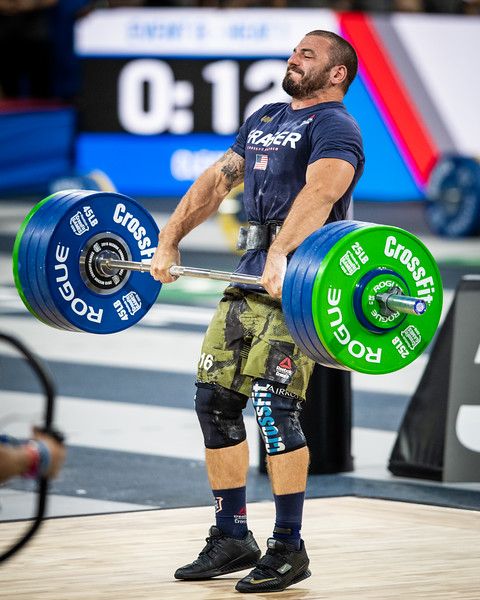
That word specified is important here. Olympic weightlifting isn’t for a generalist exerciser.
Being good at Olympic lifts makes a great foundation for practically every other sport on Earth, yes. They’re effective at improving mobility and building a strong and explosive posterior chain, which is why everyone from NFL players to speed skaters usually train derivatives of Olympic lifts, like cleans and power jerks.
But these athletes seldom train full snatches and clean and jerks because the cost-benefit analysis doesn’t quite add up. It takes too much training to safely do a great snatch when there are other, less time-intensive ways to build great mobility and posterior chain power.
“I worked with the Chicago Bulls for three-and-a-half years and we did variations of the Olympic lifts with all the players,” says Mike Gattone, USA Weightlifting’s Senior Director of Sport Performance and Coaching Education. “It’s something we believed in a lot. Were they doing full snatches and full clean and jerks from the floor? No, they weren’t. They were doing variations like power snatches from the knees, power cleans from blocks, or push presses.”
How Expert Coaches Prep Athletes for Olympic Lifts
So even elite, otherwise well-rounded athletes don’t do Olympic lifts. The maneuvers are too complicated to do them well and still focus on their sport of choice.
New York-based physical therapist Steve Horney likes to say that fitness should be slow cooked.
“It just takes time for your tendons and for your muscles to adapt over time, and you really want to be mindful of your chronic workload and your acute workload,” he says. “The rules for all strength and conditioning is respecting what the body is habituated to. I don’t care whether it’s Pilates or CrossFit, you have to respect those rules. Point blank, period, hard stop.”
Most weightlifting coaches have a laundry list of prerequisites you need to be capable of before you even think about doing a snatch. Heads Slaughter’s list includes a flawless deadlift, squat, and overhead squat. Horney has eight “Foundations of Movement” that include a perfect Wall Angel, Rotating Plank, and Bridge Squeeze. Gattone’s includes overhead squats, front squats, a great military press, the ability to get a neutral spine, and more.
“You want to do it safely, and for that it takes a ton of patience.”
“Until you’ve built a base of mobility and stability, until you’ve gone through learning and teaching progressions, you’re not going to put the bar on the floor and do full lifts,” says Gattone. “It’s like Monopoly: Do not pass Go.”
However a coach judges your ability to do Olympic lifts, they all agree on one thing: it takes a damn long time for the general population to achieve mobility benchmarks needed to do it safely.
“It’s such a skill that has so many components and so many joints and so many ranges of motion and so much cueing that needs to end up being automatic for it to look the way it’s meant to look,” says Horney. “You want to do it safely, and for that it takes a ton of patience.”
Weightlifting Programming in CrossFit Doesn’t Fit These Parameters
But CrossFit has no standardized protocol that gyms must follow for determining when an individual is capable of safely performing Olympic lifts.
If you’ll allow me to slip into the first person for a moment: I spent two years training at a Manhattan CrossFit gym where customers had to complete three one-hour lessons in barbell training before attending workouts with the regular gym-goers.
Three hours of class, then you’re joining the rest of the gym in their standard Workouts of the Day. One such “WOD” I completed was 20 full snatches, followed by a 500 meter run, repeated five times.
“If someone wants to learn how to do the technique correctly and safely, it’s better to have multiple sets than a long string of reps, and to utilize different variations of the movements,” says Heads Slaughter.
“In our Level 1 coaching at USA Weightlifting, we recommend not doing full lifts over five repetitions because they are very complex and they require a high rate of speed,” says Gattone. “Technique can start to break down, neuromuscular efficiency will start to go down. You can get lifts higher than five reps, but it might be in a complex—like front squats to jerks.”
He concedes that CrossFitters may be doing the lifts with different intentions to weightlifters.
“In USAW, when I think of full body, explosive lifts, I’m thinking of them to develop power,” he says. “I’m not thinking of them as a tool to raise your heart rate. So something like a kettlebell swing may be a safer choice for that type of performance because for me, (Olympic lifts) are a strength and power exercise.”
CrossFit Should Stick to Non-Barbell Versions of Olympic Lifts
To sum up the issue thus far:
So what is a massive, influential brand like CrossFit to do? They want to promote the benefits of endurance, strength, flexibility, power, speed, coordination, agility, balance, and accuracy. But the fact is that the average person shouldn’t attempt Olympic lifts without dedicated, long-term coaching—training that is too specialized for regular CrossFitters.
“Based on the average mobility and training background of people walking around America, for someone dropping in and just starting off (with lifting), yes, I would say full Olympic lifts would probably be a more complex choice than you would need to do,” says Gattone. He emphasizes that he’d also advise against running a marathon if you can’t finish a 5k, or rolling with jiu jitsu black belts on your first day in class.
If you want to make the average person as fit as they can, CrossFt is a great way to do that. But instead of training an explosive posterior chain with Olympic lifts, do kettlebell snatches, clean and jerks, and derivatives.
“Someone could more quickly and easily perform a kettlebell snatch, I think it would click better with the general population,” says Heads Slaughter. “For athletes, (Olympic weightlifting) is not the challenge people think it could be. But if you’re talking about the general population, giving someone a kettlebell is certainly going to be less intimidating for them. There’s a lot more room to maneuver the body in the way they want to.”
She emphasizes that there’s still a technique to kettlebell exercises, and she’s right that this bears emphasis: just because Olympic lifts are difficult, it doesn’t mean that every other exercise is foolproof. Train intelligently and under supervision of a professional.
“With high volume workouts, using the kettlebell is less complex and still gets the stimulus that (CrossFit trainers are) trying to achieve,” says Horney. ”It’s not identical to getting explosive with appropriate weight on the barbell. It’s not the same, but I think it checks enough boxes.”
Kettlebells aren’t the only options, either; variations of Olympic lifts can be done with dumbbells, medballs, or weight plates too. All these tools (and in some cases, even sandbags) require less technical mastery than the barbell. That said, it’s important that proper technique is always used, no matter what exercise or implement you choose.
When it comes time for the CrossFit Games and the competitive, professional season, when the field is narrowed to only the most elite of the elite—that’s when Olympic weightlifting events should have a home in CrossFit. These athletes have the resources, ability, and most importantly, the training time, to learn to do the Olympic lifts properly.
I like to follow the spirit of CrossFit’s law, rather than the letter: you don’t have to specialize to be well-rounded. They should just put Olympic lifts in the “specialized” category.
Source: Read Full Article
